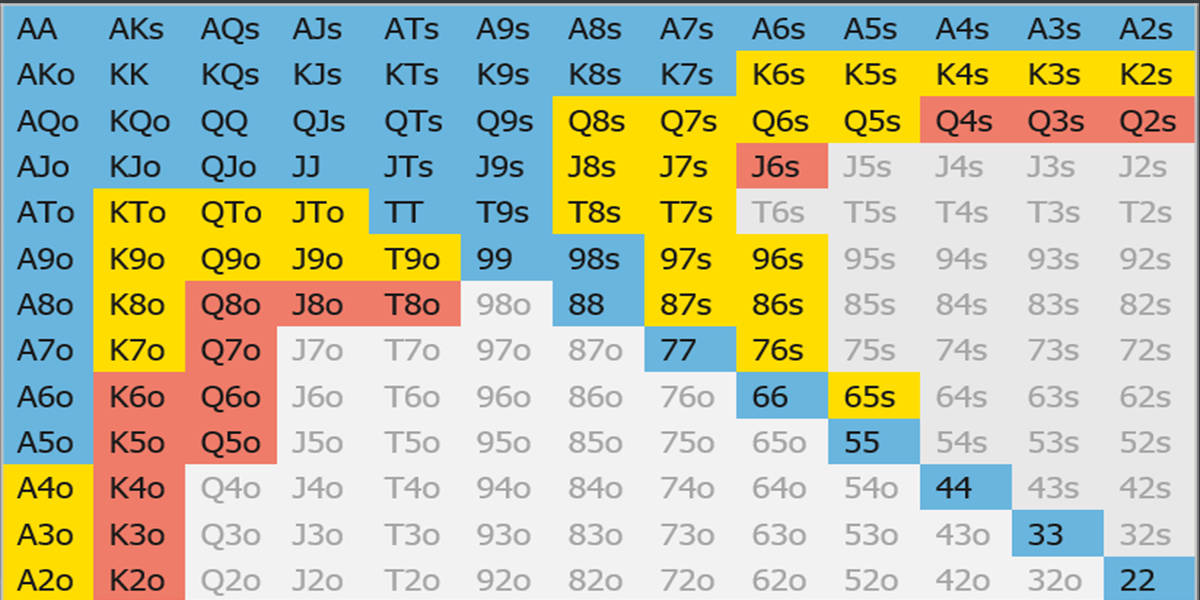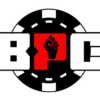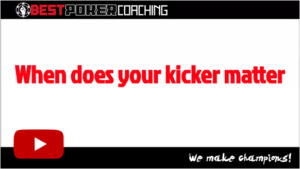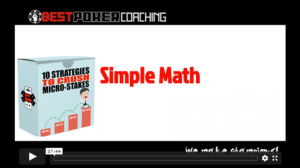Since Spin & Go tournaments are 3-handed, the player on the Button is the first to act preflop.
The Button is a powerful position because we raise to steal the blinds, limp to see a cheap flop in position (not always recommended), and can also fold and lose nothing (since we’re not posting a blind). When we’re on the Button, we will be raising as well as pushing all-in with a wide range of hands.
Let’s start with the chart below for our push/fold strategy.
PUSH/FOLD CHART ON THE BUTTON
The color-coding represents hands to go all-in with at certain stack sizes. Remember, though, that stack size means ‘effective stack size‘. Blue = shove with any stack size Yellow = shove with only less than 12BBs Red = shove with only 6BBs or less If you have 3BBs or less, go all-in with any hand. Ok, so you have the push/fold chart. Now let’s take a look at a few examples.
First example.
We’re on the button with ATo and we have 9BB in our stack. The small blind has us covered and the big blind is on life support. In this situation, we should definitely shove with ATo. The small blind is likely to fold without a strong hand.
On the other hand, we’re very likely to get a call from the big blind with a very wide range of hands, sometimes any two cards. Against any two random cards, ATo has 63% equity. If the big blind folds, we pick up an additional 1.5BB. So either way, it’s a winning play.
Another example.
We’re on the button with K9o and have a 15BB stack. The big blind has us covered. Should we shove here? No.
Since stacks are deeper, we’re only getting called by better. So going all-in is pure spew. Instead, go ahead and open raise for 2BB, take our preflop fold equity, and protect our stack.
If we get 3-bet, we can fold. If we get called, we can play a raised pot in position with the initiative. And if both blinds fold, that’s perfectly fine as we pick up some dead money.
One more example.
We’re on the button holding 97o with only 3BB left in our stack. Both blinds have us covered.
Should we ever fold? Well 97o is a pretty weak hand, however, going all-in here is actually correct.
There is a chance both blinds fold, in which we’ll add another 1.5BB to our stack and live to fight another round. If we get called, we’re probably going to need some luck. But that doesn’t make it a bad play.
Because if we fold. We’ll be in the big blind the next hand with only 2BB left AND last to act. He who shoves first holds the keys.
Ok, so you have the push/fold chart. Now let’s take a look at a few examples.
First example.
We’re on the button with ATo and we have 9BB in our stack. The small blind has us covered and the big blind is on life support. In this situation, we should definitely shove with ATo. The small blind is likely to fold without a strong hand.
On the other hand, we’re very likely to get a call from the big blind with a very wide range of hands, sometimes any two cards. Against any two random cards, ATo has 63% equity. If the big blind folds, we pick up an additional 1.5BB. So either way, it’s a winning play.
Another example.
We’re on the button with K9o and have a 15BB stack. The big blind has us covered. Should we shove here? No.
Since stacks are deeper, we’re only getting called by better. So going all-in is pure spew. Instead, go ahead and open raise for 2BB, take our preflop fold equity, and protect our stack.
If we get 3-bet, we can fold. If we get called, we can play a raised pot in position with the initiative. And if both blinds fold, that’s perfectly fine as we pick up some dead money.
One more example.
We’re on the button holding 97o with only 3BB left in our stack. Both blinds have us covered.
Should we ever fold? Well 97o is a pretty weak hand, however, going all-in here is actually correct.
There is a chance both blinds fold, in which we’ll add another 1.5BB to our stack and live to fight another round. If we get called, we’re probably going to need some luck. But that doesn’t make it a bad play.
Because if we fold. We’ll be in the big blind the next hand with only 2BB left AND last to act. He who shoves first holds the keys.
QUIZ TIME
Study the chart above and apply it to the following quiz questions. Then check your answers below the banner. Again, no cheating!
Questions:- We are on the BTN with K5o and everyone has more than 15BBs. What do we do?
- We have 22, the BB has 10BBs, and the SB has 20BBs, we have 20BBs. What do we do?
- We have 72o on the BTN. The SB has 2BB and the BB has 3BB.
- What is the stack size that we shove with A4o?
Answers:
- We fold. We need everyone to have 6BBs to shove
- We shove. 22 we shove at any stack size
- We shove. We shove any hand at effective stacks of 3 and lower
- We will shove with A4o with 12BB or less



